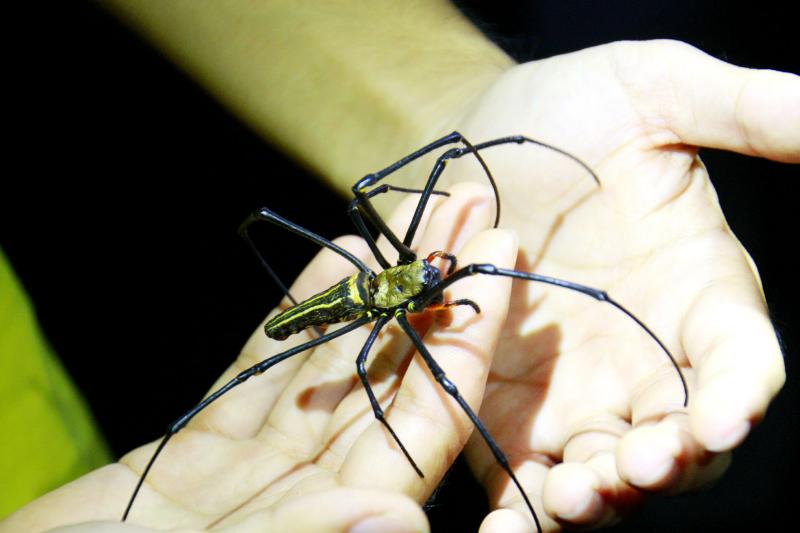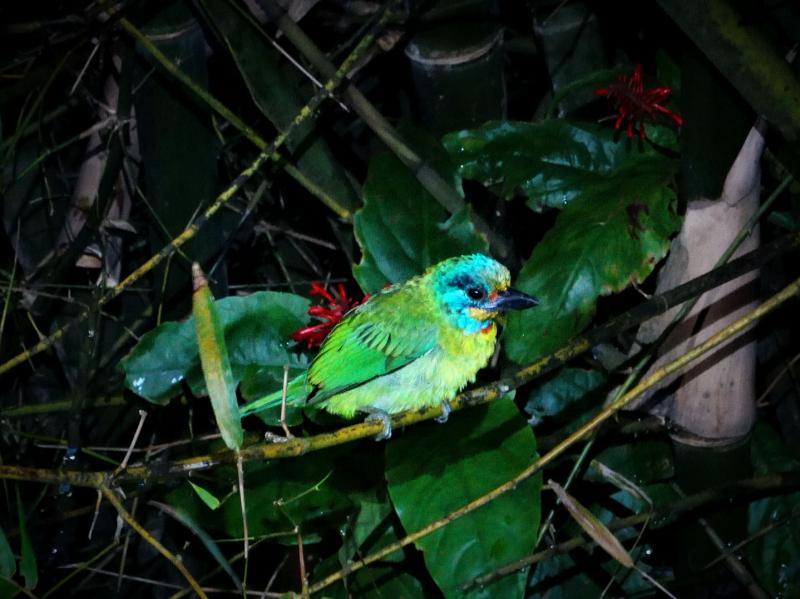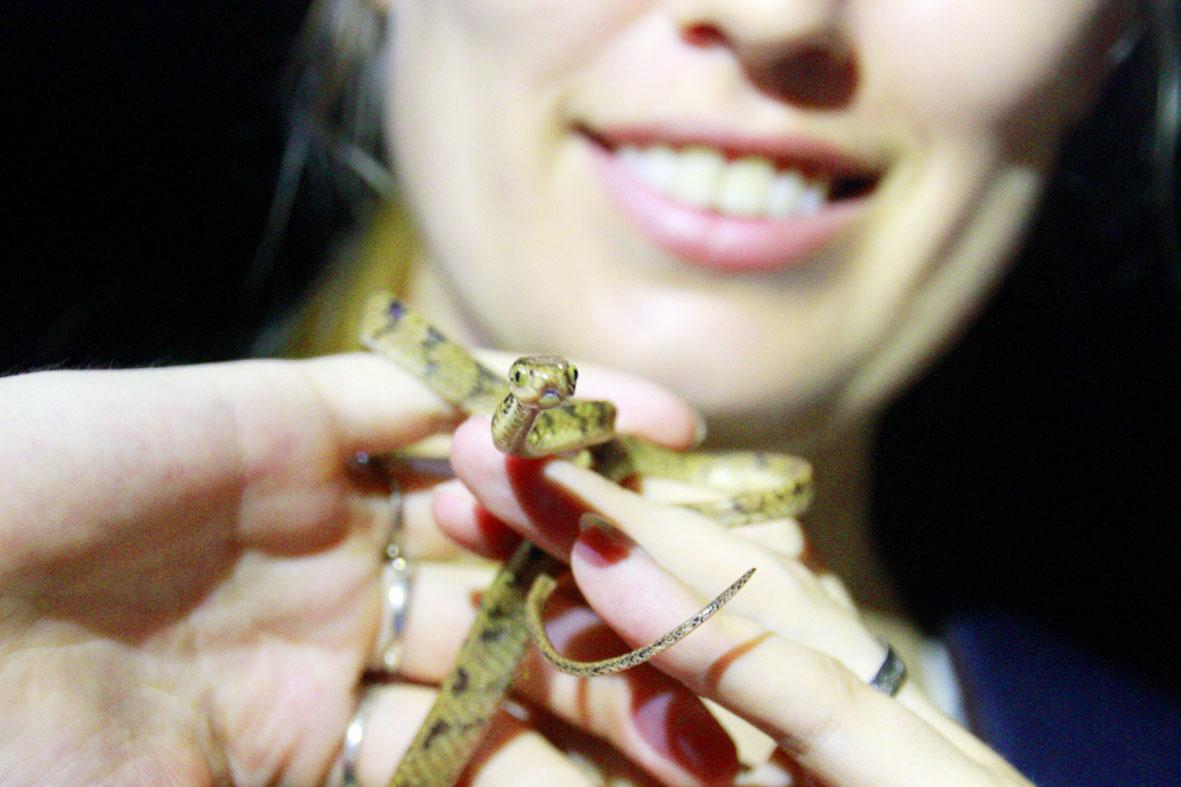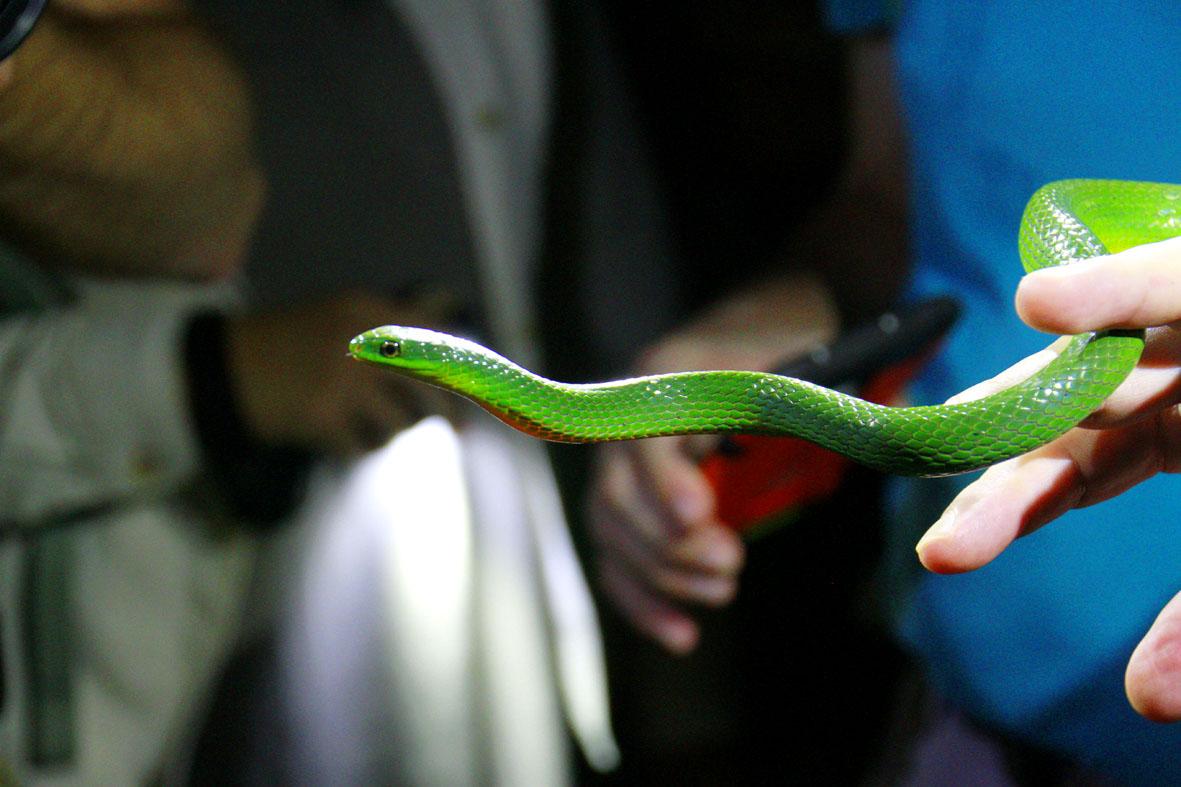“Oh my gosh,” exclaims one of our hiking party as an enormous giant golden orbweaver (Nephila pilipes) crawls up the face of another, its leg-span wider than the palm of his hand.
These large gold and black spiders are commonly seen at the side of Taipei’s mountain trails, sometimes even crossing the entire trail. Many have had the unpleasant experience of walking face-first into one of their webs, but having one crawl over your face may be a bit much for most.
Starting at the China University of Science and Technology (中華科技大學), we soon discover stage six of the 92km Taipei Grand Trail (台北大縱走) is alive with these spiders, along with an abundance of other biodiversity, even as it passes through the heart of Taipei.

Photo courtesy of Candy Huang
This roughly 10km stretch of trail also boasts some world famous views of Taipei 101, as it climbs the Four Beasts Ridge (四獸山) and Thumb Range (拇指山). It intersects with Tiger (虎山), Elephant (象山), Leopard (豹山) and Lion (獅山) mountains trails, before ending at Fuzhoushan (福州山) and Fuyang Eco-park (富陽自然生態公園).
LIFE ON THE TRAIL
As soon as we start, we find some sleeping grass lizards, and next to them a temple tree frog (Kurixalus idiootocus). Various frogs sit around in trees and along the sides of a small stream. We pass by a small green tree viper (Trimeresurus stejnegeri) resting up in the foliage, slightly too high for a close look.

Photo: James Osborne
Moments later we find a greater green snake (Ptyas major) sleeping in a shrub. These non-venomous snakes have been by far the most common snake we have encountered along the trail so far.
It is best to avoid handling wildlife, but with so many of our group on their first night hike tonight, having a closer look is such a good educational opportunity. We carefully bring it down and let it crawl from arm to arm. These are docile snakes, and will remain quite relaxed if not gripped. It is always good to showcase how peaceful snakes can be.
We meander up the gentle incline of the stone walkway to the sounds of owls and tree frogs. Despite the close proximity of downtown Taipei, the sounds of the city are muted by the dense forest. An owl swoops from a tree above our heads as we pass a small Buddhist shrine in the hollow of a tree.

Photo courtesy of Candy Huang
Here we spot the giant golden orbweaver. Of course it draws everyone’s awe and attention. Janus, an entomology student with us, reaches down to its web, and gently allows the spider to crawl up onto his arm. Naturally the group lets out some exclamations of shock. But he assures us that they are harmless, and only bite if you are rough with them. To illustrate his point, he allows it to crawl over his face. He then places it back on its web.
“We’ve got a slug-snake,” someone shouts as I’m trying to film another green tree viper. The night is off to a great start already. We crowd around for a closer look at Taiwan’s cutest and most docile snake, the Formosa slug snake (Pareas formosensis). As the name suggests, these snakes feed exclusively on slugs and snails. It is a treat to find one. Although they are common, it is the first we have found on the Grand Taipei Trail so far.
Further up the trail a venomous Taiwanese habu (Protobothrops mucrosquamatus) is slithering across the path. Contrary to slug snakes, these can be dangerous. But left alone they are no threat to anyone.

Photo courtesy of Candy Huang
A couple snakes clamber in the trees overhead as we approach the ridge-top. From here we get some amazing views right down over Taipei 101 and the heart of Taipei. After a few photos, our team is ready to move on and see more of the real splendor of the trail; it’s amazing creatures.
We are not disappointed, as sleeping beside the ridge top trail is a beautiful Taiwan barbet (Psilopogon nuchalis), also known in Chinese as the “five-color bird” (五色鳥) due to its many colors. Brilliant green, with patches of red, orange, yellow and blue around their faces, these birds are the jewels of Taiwan. Although common, they tend to be hard to see high in the tree-tops. We are lucky to get a close look at one on its sleeping perch so close to the trail.
Before the highest peak, we get an up close look at a flying squirrel munching on leaves in a trail-side tree. Again, this is an exciting first-time encounter for many in our group. We leave it to its dinner and continue on up and over the summit.
CEMETERIES
As we reach the junction at the top of Elephant Mountain it is almost midnight. Due to favorable weather conditions, we’ve decided to do stage six on a Wednesday, so many of our team must work in the morning. As such our party splits with half of the group taking the shorter descent back down the Elephant Mountain (象山) trail. Five of us continue on.
The remainder of the ridge down is full of life too. A green tree viper sits in ambush atop the leaves of an elephant’s ear (Colocasia). Another greater green snake sleeps in a tree, and then we soon walk by another. High in a tree, a cat snake (Boiga kraepelini) makes its way from one branch to another.
The trail soon drops down and emerges in a small suburb of Taipei City. The final couple of kilometers of stage six combine segments of forest trails, temples, farms and roads, as well as a section of road through a cemetery. It is approaching 2am, so we pick up the pace as we navigate the network of paths that make up the Fuzhoushan (福州山) area.
We stop at the peak to soak in some more views. The city-scape is darker now with Taipei 101’s lights turned off. Climbing on the beams of an abandoned rest shelter at the peak, someone spots something. “James, you should come check this out.” Yet another green tree viper is climbing around on some old wires. It’s fascinating to see a jewel of nature interacting with the derelict human structure.
From here we continue at quite a pace down to Fuyang Eco-park and finish the hike. A 10km hike is more than enough for a weeknight after work. At close to 3am, we are pretty keen to get home to bed.
James Osborne spends a lot of his time exploring Taiwan’s abundant biodiversity. Recently his focus has been to film the Taipei Grand Trail at night, and share all the nocturnal wildlife discoveries. Check out his YouTube channel (James Osborne) for these videos and other ecological adventures.

One of the biggest sore spots in Taiwan’s historical friendship with the US came in 1979 when US president Jimmy Carter broke off formal diplomatic relations with Taiwan’s Republic of China (ROC) government so that the US could establish relations with the People’s Republic of China (PRC). Taiwan’s derecognition came purely at China’s insistence, and the US took the deal. Retired American diplomat John Tkacik, who for almost decade surrounding that schism, from 1974 to 1982, worked in embassies in Taipei and Beijing and at the Taiwan Desk in Washington DC, recently argued in the Taipei Times that “President Carter’s derecognition

This year will go down in the history books. Taiwan faces enormous turmoil and uncertainty in the coming months. Which political parties are in a good position to handle big changes? All of the main parties are beset with challenges. Taking stock, this column examined the Taiwan People’s Party (TPP) (“Huang Kuo-chang’s choking the life out of the TPP,” May 28, page 12), the Democratic Progressive Party (DPP) (“Challenges amid choppy waters for the DPP,” June 14, page 12) and the Chinese Nationalist Party (KMT) (“KMT struggles to seize opportunities as ‘interesting times’ loom,” June 20, page 11). Times like these can

June 23 to June 29 After capturing the walled city of Hsinchu on June 22, 1895, the Japanese hoped to quickly push south and seize control of Taiwan’s entire west coast — but their advance was stalled for more than a month. Not only did local Hakka fighters continue to cause them headaches, resistance forces even attempted to retake the city three times. “We had planned to occupy Anping (Tainan) and Takao (Kaohsiung) as soon as possible, but ever since we took Hsinchu, nearby bandits proclaiming to be ‘righteous people’ (義民) have been destroying train tracks and electrical cables, and gathering in villages

Dr. Y. Tony Yang, Associate Dean of Health Policy and Population Science at George Washington University, argued last week in a piece for the Taipei Times about former president Ma Ying-jeou (馬英九) leading a student delegation to the People’s Republic of China (PRC) that, “The real question is not whether Ma’s visit helps or hurts Taiwan — it is why Taiwan lacks a sophisticated, multi-track approach to one of the most complex geopolitical relationships in the world” (“Ma’s Visit, DPP’s Blind Spot,” June 18, page 8). Yang contends that the Democratic Progressive Party (DPP) has a blind spot: “By treating any